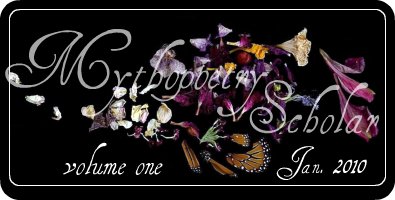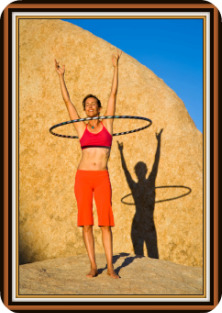
Annual Reflections In Depth Perspectives

scanner Art by Richard Lance Williams
This Issue: Health & Well-Being
The New Hoop -Sara Munro
More Than A Kids Toy; The Hoop is Here to Stay
Iconic, symbolic, and historic, the “hula hoop” has returned to the main stage of public consciousness. It’s official. Michelle Obama swiveled her hips with children on the White House Lawn to promote healthy eating and life-styles.1 In a culture that promotes consumption of processed, preserved food laden with chemical additives while interacting with cathode-ray tubes and computer screens this seems noteworthy. Is it possible that a new era of health consciousness that embraces the power and usefulness of something as simple as the hoop emerges?
An ancient and modern toy, the hoop may not appear to offer much that’s new or relevant. The Egyptians wound grape vines together to create looped toys, the Australians used wooden hoops in P.E. classes in the ‘50s, and Whamo sold over 100,000,000 million hoops in one year before the trend rapidly fizzled. Many recall the product’s sky-rocketing ascension, the public’s obsession followed by its quick denouement, only to dismiss the hoop phenomenon as another example of American mania and an over enthusiasm for things without substance.
News of the First Lady hooping on the White House lawn does not mention that for over a decade now, a small fringe group of creatives, has been working and playing with slightly modified version of this circular tubing and revolutionizing its uses and applications. This ingenious lot made a few simple yet significant changes to what most think of as the Whamo kid’s toy, the “hula hoop.” Bringing it “back to the garage,” where Richard Knerr and Arthur Spud Melin re-invented it over 50 years ago, these new hoopers use materials purchased at the hardware store they hand built a bigger, heavier hoop and wrapped it in friction tape. These changes have not only made hooping easier and more fun, but have allowed for entirely new experiences. The hoola hoop has become, simply, “the hoop.”
By bringing their bodies, minds and spirits into relationship with the hoop, today’s hooping pioneers are opening a new portal for exploration of fun, fitness, and self-expression. From exercise and fitness, meditation, dance and self-expression, hooping can be applied to meet specific outcomes in a wide variety of settings. From ice breaking, creativity enhancement, team building in the corporate environment, to children’s physical education classes, to fitness and dance for adults.
Those who have creatively embraced the hoop have done everything from losing weight, to reclaiming their sensuality, to finding joy in their bodies. They’ve created teacher certification programs, performance troupes, educational programs for children, and offers for the corporate environment. Many light hoops on fire in performance and dance with this sacred element that changes matter into energy. Celebrities like Beyonce hooped in her music video, Marissa Tomei appeared on the Ellen Degeneress show announcing she used the hoop to get in shape for her role as a stripper in “The Wrestler.” This is just the beginning. Go to hooping.org and you’ll find an extensive list of small privately run hooping outfits purveying hoops and their benefits.
Undoubtedly, the hoop is making an unprecedented comeback. This re-emergence suggests there is more to this plastic play thing than meets the eye, and that the American public is ready to take a step deeper into its spinning circle.
It is common knowledge that being physically fit has mental benefits. As the west embraces yoga, mostly from a practice of physical asana, we slowly begin to understand that being present in our bodies directly affects our spiritual lives. But very few fitness tools are known for both their qualities associated with the spiritual path and physical fitness. The hoop presents a practice uniting fitness and transformation.
The spiraling, mind-body-spirit journey goes far beyond the obvious physical benefits. Through the hooping experience and committed practice of hooping, one discovers the power of this vehicle to connect with a profound felt sense that simultaneously includes the self yet goes beyond the self. Because the hoop is innately a rhythmic instrument that one plays around the physical body, the process of hooping has the surprising power to draw one into the present, the place where transformation can occur.
*
*
RHYTHM
Everyone has rhythm. From our earliest days, we listened to and felt life pulse all around us as it originated from our mother’s breath and her never ceasing heart beat. We could not know life without knowing rhythm. Our lives and rhythm were inseparable. We knew this not through the thinking analytical mind, but through the intelligence of our bodies. Responding to the brilliant call of life, our own heart imitated hers and we felt her heart beat in perfect rhythm with our own. As our bodies became, we experienced the bliss of union with another.
We felt life rhythmically throb through our very beings, as it sped up and slowed down depending on our mother’s experience. Later, we would learn that our rhythm was not only the same as hers, but uniquely different and our own. Perhaps this was our first experience of paradox. We are one, yet we are simultaneously separate.
As we grew up many of us drew further and further away from our natural sense of rhythm. Forgotten or squelched by culture and religion, guilt and shame, misshapen by trauma or self-limiting beliefs, rhythm hangs on in our own beating heart. It never deserts, it remains in residence in our cells, spinning in the mitochondria, waiting for us to journey into our essence, into our living bodies in their fullness.
So, when people tell me they don’t have rhythm, I make sure to smile as I say, “Ah, but you do. You just don’t remember it.” And I invite them to take a journey in the hoop.
THE HOOP AS VESSEL FOR TRANSFORMATION
The hoop offers an invitation to laugh and play, to experience joy, to be large and take up space, to relax the thinking mind and allow meditative rhythmic movement. It offers an opportunity to remember, identify, and express unique rhythm. In this way, the spinning hoop becomes a sacred circle, a container or vessel for experience, a safe space with clearly delineated boundaries within which transformation can occur.
Within the context of the powerful metaphor of the circle, the “hooper” explores their body and rhythm in space. While in intimate conversation with one’s own form in action and in relation to the hoop, patterns emerge, the primal is remembered, new rhythms are created. Through the process of finding one’s unique relationship with the hoop, one’s mythology unfolds, spoken through the language of the body, acted out in the circle of the hoop. As the hooper is guided to return to center, to feel the ground, awaken the feet and legs, a practice is established, and transformation begins. Regardless of experience level, there is an opportunity to become observer.
After the initial struggle with self and the hoop and after practice and repetition that builds muscle memory, hooping becomes a vehicle for relaxation, meditation or self-expression. The rhythmic conversation between hooper and hoop comes from an embodied knowing, not the thinking mind. Thought has dropped away and the body dances to its own music, heard and felt through sensation. With body, mind and spirit engaged, expansion occurs and portals of possibility open.
MYSTERY
There is something mystical and inexplicable about the hoop experience. I have seen people who have never hooped, who don’t think they could, hoop for up to three hours. I have had marathon sessions in the hoop. Stories of people hooping for five to six hours at a time are not uncommon. What is so galvanizing? For me, there is the sense of coming home.
Through direct physical participation with the sacred geometry of the hoop, hoopdance becomes a form of experiential, interactive “sacred physics.” The hooper becomes the axis of hundreds of invisible circular hoop pathways around the body. Together hoop and human become a spirograph spinning trajectories of energy through space. If you could trace these shapes, they would be explicable through mathematical equations, but their felt sensation is difficult to articulate in language.
The laws of physics govern the movement of the hoop. Inertia, momentum, centripetal force and gravity impact the hoop in all the expected ways. When the hoop is spinning on its axis or cleanly on a plane, it moves easily, and little effort is needed to maintain its motion. As the hooper learns and understands its movement in space, she can alter the hoop’s course with her body. A slight push in just the right place at the right time can a change the axis or direction of spin, shift to another plane of rotation, elevate or lower the hoop as it emulates the shape of a single strand of the DNA helix. The hooper dances with and as one with the geometry of the hoop and its physical properties.
Perhaps this is not so unusual. The spiral is the oldest symbol.For millennia, Sufi Whirling Dervishes have been spinning as a way of finding the center of the center and offering devotion to God. We live in a spiral universe, on a planet turning on its axis at 1070 mph (at the equator,) and traveling in a circle around the sun at 67,000 mph. The energy center of our cells, the mitochondria have “respiratory electron transport chains” which all spin. Everything is spinning! Is there some connection between what happens above and below and our profound sense of peace in the center of the spiral movement of the hoop.
This time around, it looks like the hoop may be here to stay. What was only nascent in the hoop experience 50 years ago is at last birthing itself through the exploration of today’s hoopers, who are looking more deeply into the hoop and slowly mining and sharing its timeless valuable facets. The hoop could be the next revolutionary tool that assists us better understand and experience the body-mind-connection. Talk to any group of committed hoopers, male or female, young or old, and they will tell you that the hoop is changing their lives.
notes
1Malcom, Andrew. “Michelle Obama Hula-Hooping Our Way To Health,” LA Times on the Web Oct. 21, 2009, Nov. 1, 2009. http://latimesblog.latimes.com/washington/2009/10/michelle-obama-hulahoops-her-way-to-health.html.
***************************** ******************************
******************************

Author Bio
Mount Holyoke College graduate, Sara taught writing at Phillips Academy, Andover, and moved to Santa Barbara in 1988 to run the Laguna Blanca School’s drama program. Lifelong passions for movement, teaching and creative expression, merged when Sara started hooping in 2002. Galvanized, she founded Flame Fatale. A professional hoopdancer, she develops and launches hoopdance offers for students, adults and audiences throughout Southern California. She has also worked for outdoor industry leader Patagonia, Yosemite Search and Rescue, and as a reporter for the The Hi-Desert Star.
photo courtesy Greg Epperson gregepperson.com
Website: www.flamefatale.net
Inside This Issue: back

